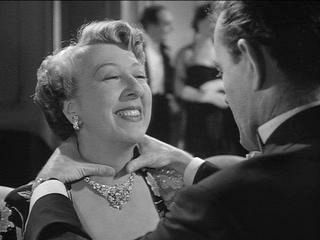In Strangers on a Train we saw that by concealing the murder Hitchcock instilled the killer with power. The same applies here in Psycho. In the case of the earlier film, this power is expressed in terms of the effortlessness and inevitability of the killing. Hitchcock plays on this aura of power throughout the rest of the film as Bruno is constantly popping up out of the blue. At one point, he almost kills a woman at a party while demonstrating how easy it is to strangle someone.NOTE 8

Bruno (Robert Walker) nearly strangles a woman at a party in Strangers On a Train.
(© 1951, Renewed © 1951 Warner Bros. All rights reserved.) |
In Psycho, the attacker is concealed by the power of editing and this power grows as a result of being concealed. In this case, the power is not directly associated with physicality, but, rather, with a sense of the unknown. This attacker, who until this point is a mere voice up in the old house, has violently entered the world that we have been sharing with Marion. Because we don't get a clear view of the attacker, this person becomes an unknown force with nearly unlimited power.
In looking at the timing of the sequence in Dial M for Murder, I noted that the action was given perfect narrative form by the strict division of each segment into thirty second parts. In the case of Psycho, the same principle is at work as the introduction is given forty seconds (with seven cuts), the main action is given twenty seconds (with twenty-eight cuts), and the conclusion is given forty seconds again (with six cuts). The timing of the sequence again gives us a sense of narrative unity. We are given as long with Marion in her moment of ecstasy as we are given in her agony. This mini-narrative has a long introduction and a long conclusion, with the blast of violence that interrupts our privacy with Marion lasting only one fifth of the time of the sequence. The drama of the attack does not take away from our perception of her as a person of sympathy and interest because this outburst is sandwiched between two sequences that mirror each other not only in timing and number of cuts but also in the degree of emotion felt by Marion. There is a balance and wholeness to the sequence, and so, just as with Dial M for Murder, we get a sense of completion when the scene is over. We must refocus. In this case our refocusing involves moving to an almost entirely new story. The unity and finality of the murder scene has prepared us for this move.
The aftermath of the murder in Psycho dramatically recalls some of the features from Blackmail. As we weren't familiar with the violent side of Crewe, neither were we familiar with the violent side of Norman Bates. We only knew him as the shy young man with poor social skills who awkwardly tried to befriend Marion by inviting her into his parlor. Likewise, we didn't expect anything bad to happen when Crewe invited Alice into his studio.
In Blackmail, Hitchcock uses our response of shock to great effect in filming the aftermath of the murder. In Psycho, Hitchcock captures Marion's stare as she slides down the bathroom wall. She reaches out to us but we cannot help her and she slumps to her death.  But Hitchcock is not finished with Marion. She is not alive to address our shock at the murder in the way that Alice is in Blackmail, but Hitchcock allows her do it anyway. After Marion's body has slumped to the floor, Hitchcock cuts to the shower head and then to her legs in the tub. The blood that flows from her body is followed on its course towards the drain. The camera halts over the drain and then slowly begins to track in. The water spirals as it goes down the drain and dissolves into Marion's eye. As the camera pulls back in a spiral, we see her face pressed against the bathroom floor. Her eye stares at us just as Alice had stared at us.
But Hitchcock is not finished with Marion. She is not alive to address our shock at the murder in the way that Alice is in Blackmail, but Hitchcock allows her do it anyway. After Marion's body has slumped to the floor, Hitchcock cuts to the shower head and then to her legs in the tub. The blood that flows from her body is followed on its course towards the drain. The camera halts over the drain and then slowly begins to track in. The water spirals as it goes down the drain and dissolves into Marion's eye. As the camera pulls back in a spiral, we see her face pressed against the bathroom floor. Her eye stares at us just as Alice had stared at us. 
Once again, Hitchcock is cashing in on the emotionally heightened state of the audience by having the victim of the attack directly look at the audience. But we cannot help her. We are left with the indignity of her position, slumped across the bathroom floor, and the horrible abruptness of her death--at the hands of a force that, at this point in the movie, we don't yet understand.